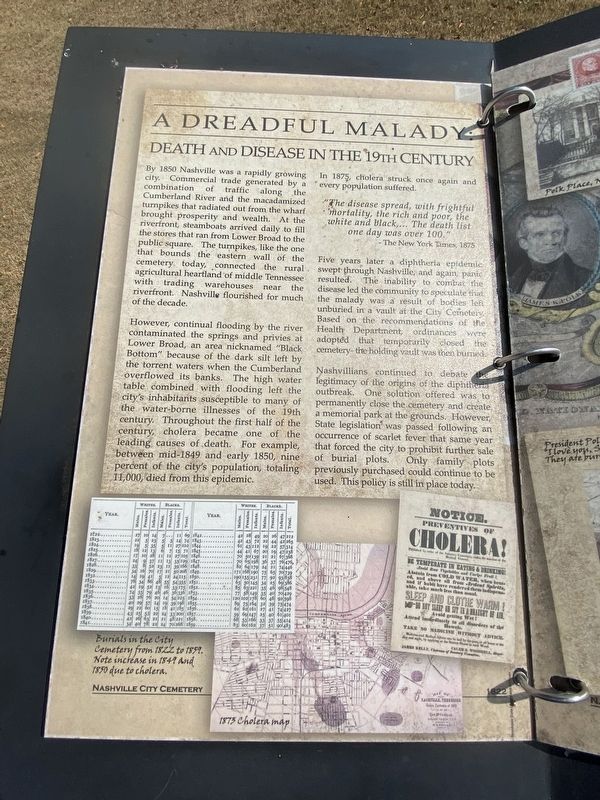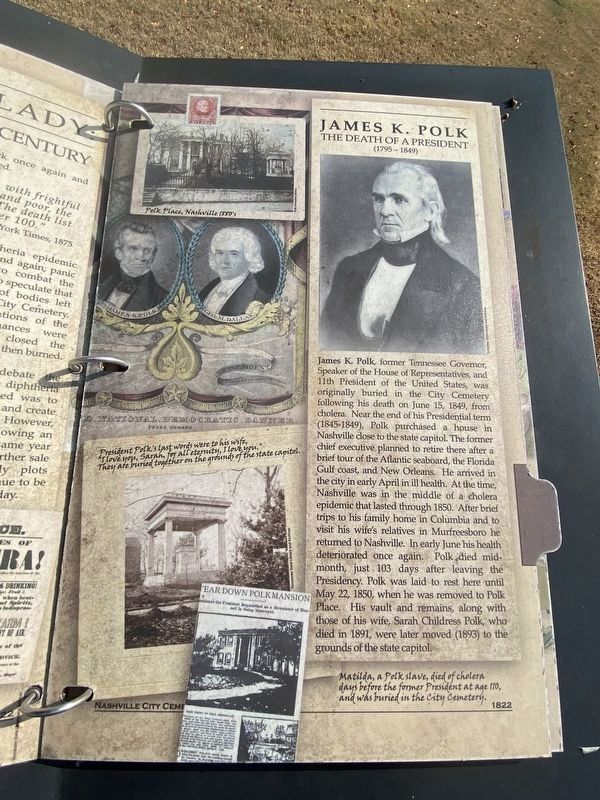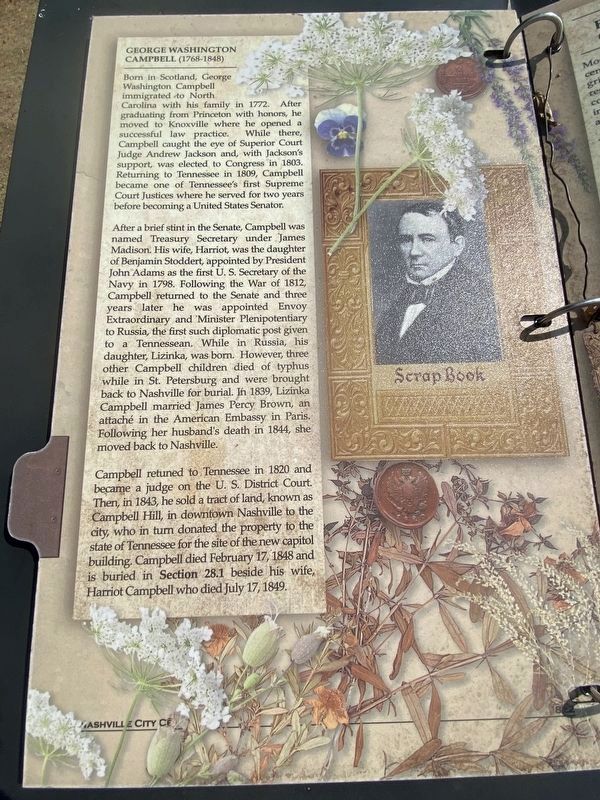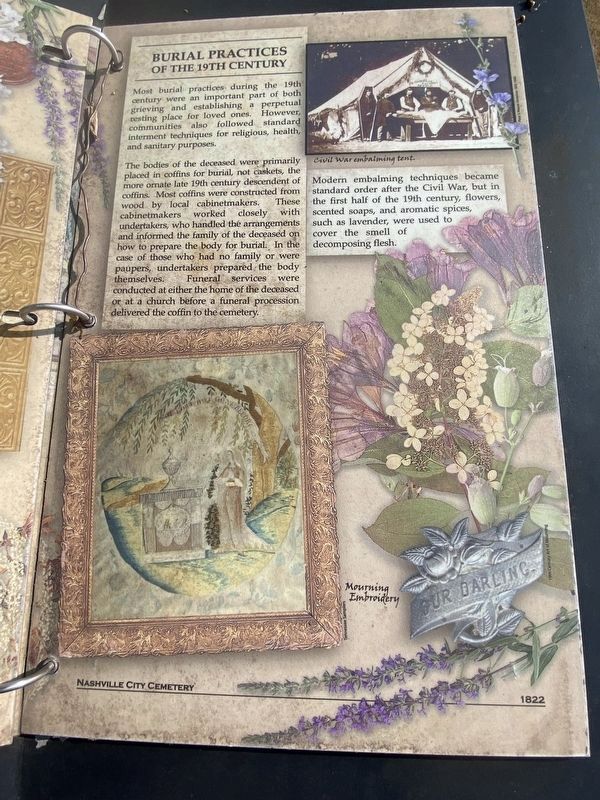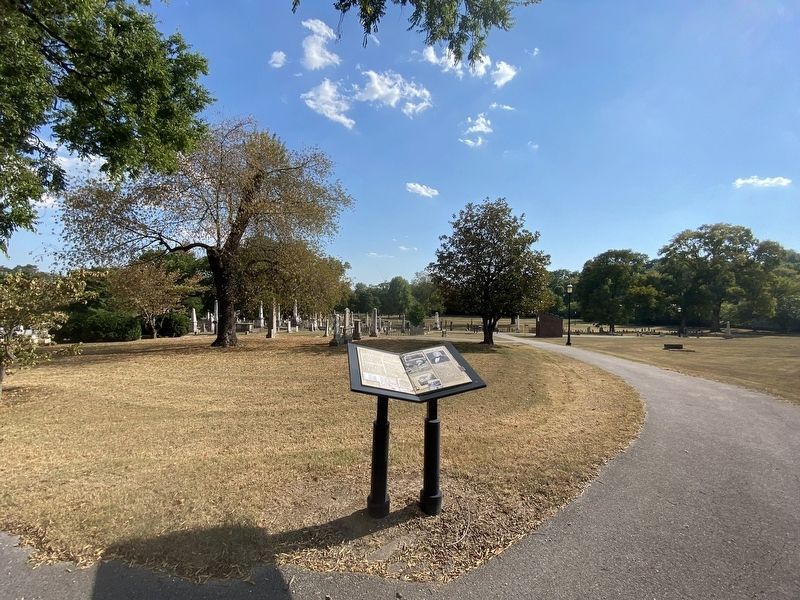South Nashville in Davidson County, Tennessee — The American South (East South Central)
A Dreadful Malady
Death and Disease in the 19th Century
By 1850 Nashville was a rapidly growing city. Commercial trade generated by a combination of traffic along the Cumberland River and the macadamized turnpikes that radiated out from the wharf brought prosperity and wealth. At the riverfront, steamboats arrived daily to fill the stores that ran from Lower Broad to the public square. The turnpikes, like the one that bounds the eastern wall of the cemetery today, connected the rural agricultural heartland of middle Tennessee with trading warehouses riverfront. Nashville flourished for much of the decade.
However, continual flooding by the river contaminated the springs and privies at Lower Broad, an area nicknamed "Black Bottom” because of the dark silt left by the torrent waters when the Cumberland- overflowed its banks. The high water table combined with flooding left the city's inhabitants susceptible to many of the water-borne illnesses of the 19th century. Throughout the first half of the century, cholera became one of the leading causes of death. For example, between mid-1849 and early 1850, nine percent of the city's population, totaling 11,000, died from this epidemic.
In 1875, cholera struck once again and every population suffered.
"The disease spread, with frightful mortality, the rich and poor, the white and black,... The death list one day was over 100."-The New York Times, 1875
Five years later a diphtheria epidemic swept through Nashville, and again, panic resulted. The inability to combat the disease led the community to speculate that the malady was a result of bodies left unburied in a vault at the City Cemetery Based on the recommendations of the Health Department, ordinances were adopted that temporarily closed the cemetery-the holding vault was then burned.
Nashvillians continued to debate legitimacy of the origins of the diphtheria outbreak. One solution offered was to permanently close the cemetery and create a memorial park at the grounds. However, State legislation was passed following an occurrence of scarlet fever that same year that forced the city to prohibit further sale of burial plots. Only family lots previously purchased could continue to be used. This policy is still in place today.
(1795 - 1849)
James K. Polk, former Tennessee Governor, Speaker of the House of Representatives, and 11th President of the United States, was originally buried in the City Cemetery following his death on June 15, 1849, from cholera. near the end of his Presidential term (1845-1849), Polk purchased a house in Nashville close to the state capitol. the former chief executive planned to retire there after a brief tour of the Atlantic seaboard, the Florida Gulf cast, and New Orleans. he arrived in the city in early April in ill health. At the time, Nashville was in the middle of a cholera epidemic that lasted through 1850. After brief trips to his family home in Columbia and to visit his wife's relatives in Murfreesboro he returned to Nashville. in early June his health deteriorated once again. Polk died mid-month, just 103 days after leaving the Presidency. polk was laid to rest here until May, 22, 1850, when he was removed to Polk Place. his vault and remains, along with those of his wife, Sarah Childress Polk, who died in 1891, were later removed (1893) to the grounds of the state capitol.
George Washington Campbell (1768-1848)
born in Scotland, George Washington Campbell immigrated to North Carolina with his family in 1772. After graduating from Princeton with honors, he moved to Knoxville where he opened a successful law practice. While there, Campbell caught the eye of Superior Court Judge Andrew Jackson and, with Jackson's support, was elected to Congress in 1803. Returning to Tennessee in 1809, Campbell became one of Tennessee's first Supreme Court Justices whee he served for two years before becoming a United States Senator.
After a brief stint in the Senate, Campbell was named Treasury Secretary under James Madison. His wife, Harriot, was the daughter of Benjamin Stoddert, appointed by president John Adams as the first U.S. Secretary of the Navy in 1798. Following the War of 1812, Campbell returned to the Senate and three years later he was appointed Envoy Extraordinary and Minister Plenipotentiary to Russia, the first such diplomatic post given to a Tennessean. While in Russia, his daughter, Lizinka, was born. however, three other Campbell children died of typhus while in St. Petersburg and were brought back to Nashville for burial. in 1839, Lizinka Campbell married James Percy Brown, an attache in the American Embassy in Paris. Following her husband's death in 1844, she moved back to Nashville.
Campbell returned to Tennessee in 1820 and became a judge on the U.S. District Court. Then, in 1843, he sold a tract of land, known as Campbell Hill, in downtown Nashville to the city, who in turn donated the property to the state of Tennessee for the site of the new capitol building. Campbell died February 17, 1848 and is buried in Section 28.1 beside his wife, Harriot Campbell who died July 17, 1849.
Burial Practices of the 19th Century
Most burial practices during the 19th century were an important part of both grieving and establishing a perpetual resting place for loved ones. However, communities also followed standard interment techniques for religious health, and sanitary purposes.
The bodies of the deceased were primarily placed in coffins for burial, not caskets, the more ornate late 19th century descendent of coffins. Most coffins were constructed from wood by local cabinetmakers. These cabinetmakers worked closely with undertakers who handled the arrangements and informed the family of the deceased on how to prepare the body for burial. In the case of those who had no family or were paupers, undertakers prepared the body themselves. Funeral services were conducted at either the home of the deceased or at a church before a funeral procession delivered the coffin to the cemetery.
Modern embalming techniques became standard order after the Civil War, but in the first half of the 19th century, flowers, scented soaps, and aromatic spices, such as lavender, were used to cover the smell of decomposing flesh.
Topics. This historical marker is listed in these topic lists: Cemeteries & Burial Sites • Science & Medicine.
Location. 36° 8.89′ N, 86° 46.244′ W. Marker is in Nashville, Tennessee, in Davidson County. It is in South Nashville. Marker can be reached from Rep. John Lewis Way South. Touch for map. Marker is at or near this postal address: 935 Rep John Lewis Way S, Nashville TN 37203, United States of America. Touch for directions.
Other nearby markers. At least 8 other markers are within walking distance of this marker. Nashville: The World of Speculation (within shouting distance of this marker); Andrew Ewing (about 300 feet away, measured in a direct line); In Memory of Charles Maddis (about 400 feet away); Cemetery Monument and Architecture (about 400 feet away); John E. Hagey (about 400 feet away); Frontier Nashville / Athens of the West (about 400 feet away); William Carroll (about 400 feet away); From Frontier to Civilization (about 400 feet away). Touch for a list and map of all markers in Nashville.
Credits. This page was last revised on February 7, 2023. It was originally submitted on October 4, 2022, by Darren Jefferson Clay of Duluth, Georgia. This page has been viewed 90 times since then and 10 times this year. Photos: 1, 2, 3, 4, 5. submitted on October 4, 2022, by Darren Jefferson Clay of Duluth, Georgia. • Mark Hilton was the editor who published this page.
